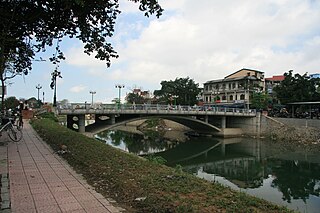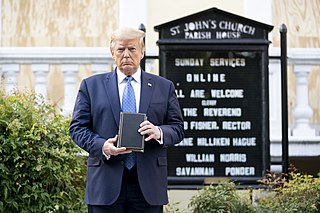
The 1968 United States presidential election was the 46th quadrennial presidential election, held on Tuesday, November 5, 1968. The Republican nominee, former vice president Richard Nixon, defeated both the Democratic nominee, incumbent vice president Hubert Humphrey, and the American Independent Party nominee, former Alabama governor George Wallace. This was the last election until 1988 in which the incumbent president was not on the ballot. This is the most recent election where a third-party candidate won an electoral vote.

The 1968 Democratic National Convention was held August 26–29 at the International Amphitheatre in Chicago, Illinois, United States. Earlier that year incumbent President Lyndon B. Johnson had announced he would not seek reelection, thus making the purpose of the convention to select a new presidential nominee for the Democratic Party. The keynote speaker was Senator Daniel Inouye of Hawaii. Vice President Hubert Humphrey and Senator Edmund Muskie of Maine were nominated for president and vice president, respectively. The most contentious issues of the convention were the continuing American military involvement in the Vietnam War and voting reform, particularly expanding the right to vote for draft-age soldiers who were unable to vote as the voting age was 21. The convention also marked a turning point where previously idle groups such as youth and minorities became more involved in politics and voting.

Beginning in late 2002 and continuing after the 2003 invasion of Iraq, large-scale protests against the Iraq War were held in many cities worldwide, often coordinated to occur simultaneously around the world. After the biggest series of demonstrations, on February 15, 2003, New York Times writer Patrick Tyler claimed that they showed that there were two superpowers on the planet: the United States and worldwide public opinion.

A police riot is a riot carried out by the police; more specifically, it is a riot that police are responsible for instigating, escalating or sustaining as a violent confrontation. Police riots are often characterized by widespread police brutality, and they may be done for the purpose of political repression.

The Chicano Moratorium, formally known as the National Chicano Moratorium Committee Against The Vietnam War, was a movement of Chicano anti-war activists that built a broad-based coalition of Mexican-American groups to organize opposition to the Vietnam War. Led by activists from local colleges and members of the Brown Berets, a group with roots in the high school student movement that staged walkouts in 1968, the coalition peaked with a August 29, 1970 march in East Los Angeles that drew 30,000 demonstrators. The march was described by scholar Lorena Oropeza as "one of the largest assemblages of Mexican Americans ever." It was the largest anti-war action taken by any single ethnic group in the USA. It was second in size only to the massive U.S. immigration reform protests of 2006.

Allison Beth Krause was a student at Kent State University and one of four unarmed students shot and killed by soldiers of the Ohio Army National Guard in the May 4, 1970 Kent State shootings in Kent, Ohio. The shootings occurred as students protested against both the invasion of Cambodia and the National Guard presence on campus.

Following the assassination of Martin Luther King Jr., a leading African-American civil rights activist, on April 4, 1968, Washington, D.C., experienced a four-day period of violent civil unrest and rioting. Part of the broader riots that affected at least 110 U.S. cities, those in Washington, D.C.—along with those in Chicago and in Baltimore—were among those with the greatest numbers of participants. President Lyndon B. Johnson called in the National Guard to the city on April 5, 1968, to assist the police department in quelling the unrest. Ultimately, 13 people were killed, with approximately 1,000 people injured and over 6,100 arrested.

Opposition to United States involvement in the Vietnam War began with demonstrations in 1965 against the escalating role of the United States in the Vietnam War and grew into a broad social movement over the ensuing several years. This movement informed and helped shape the vigorous and polarizing debate, primarily in the United States, during the second half of the 1960s and early 1970s on how to end the Vietnam War.
The Moratorium to End the War in Vietnam was a massive demonstration and teach-in across the United States against the United States involvement in the Vietnam War. It took place on October 15, 1969, followed a month later, on November 15, 1969, by a large Moratorium March in Washington, D.C.

The Hard Hat Riot occurred on May 8, 1970, in New York City. It started around noon when around 400 construction workers and around 800 office workers attacked around 1,000 demonstrators affiliated with the student strike of 1970. The students were protesting the May 4 Kent State shootings and the Vietnam War, following the April 30 announcement by President Richard Nixon of the U.S. invasion of neutral Cambodia. Some construction workers carried U.S. flags and chanted "USA, All the way", and "America, love it or leave it". Anti-war protesters shouted, “Peace now”.

The Poor People's Campaign, or Poor People's March on Washington, was a 1968 effort to gain economic justice for poor people in the United States. It was organized by Martin Luther King Jr. and the Southern Christian Leadership Conference (SCLC), and carried out under the leadership of Ralph Abernathy in the wake of King's assassination in April 1968.

The Kent State Massacre were the killing of four and wounding of nine unarmed college students by the Ohio National Guard on the Kent State University campus. The shootings took place on May 4, 1970, during a rally opposing the expanding involvement of the Vietnam War into Cambodia by United States military forces as well as protesting the National Guard presence on campus and the draft. Twenty-eight National Guard soldiers fired about 67 rounds over 13 seconds, killing four students and wounding nine others, one of whom suffered permanent paralysis. Students Allison Krause, 19, Jeffrey Glenn Miller, 20, and Sandra Lee Scheuer, 20, died on the scene, while William Knox Schroeder, 19, was pronounced dead at Robinson Memorial Hospital in nearby Ravenna shortly afterward.

The Huế chemical attacks occurred on 3 June 1963, when soldiers of the Army of the Republic of Vietnam (ARVN) poured liquid chemicals from tear gas grenades onto the heads of praying Buddhists in Huế, South Vietnam. The Buddhists were protesting against religious discrimination by the regime of the Roman Catholic President Ngô Đình Diệm. The attacks caused 67 people to be hospitalised for blistering of the skin and respiratory ailments.

The 1968 Democratic National Convention protests were a series of protests against the United States' involvement in the Vietnam War that took place prior to and during the 1968 Democratic National Convention in Chicago, Illinois. The protests lasted approximately seven days, from August 23 to August 29, 1968.

The student strike of 1970 was a massive protest across the United States that included walk-outs from college and high school classrooms, initially in response to the United States expansion of the Vietnam War into Cambodia. Nearly 900 campuses nationwide participated. The strike began May 1, but increased significantly after the shooting of students at Kent State University by National Guardsmen on May 4. While many violent incidents occurred during the protests, they were, for the most part, peaceful.
James Peck was an American activist who practiced nonviolent resistance during World War II and in the Civil Rights Movement. He is the only person who participated in both the Journey of Reconciliation (1947) and the first Freedom Ride of 1961, and has been called a white civil rights hero. Peck advocated nonviolent civil disobedience throughout his life, and was arrested more than 60 times between the 1930s and 1980s.

The King assassination riots, also known as the Holy Week Uprising, were a wave of civil disturbance which swept across the United States following the assassination of Martin Luther King Jr. on April 4, 1968. Some of the biggest riots took place in Washington, D.C., Baltimore, Chicago, and Kansas City.

On June 1, 2020, amid the George Floyd protests in Washington, D.C., law enforcement officers used tear gas and other riot control tactics to forcefully clear peaceful protesters from Lafayette Square, creating a path for President Donald Trump and senior administration officials to walk from the White House to St. John's Episcopal Church. Trump held up a Bible and posed for a photo op in front of Ashburton House, which had been damaged by a fire set during protests the night before.
The University of New Mexico bayoneting incident was a violent altercation between students protesting on the campus of the University of New Mexico (UNM) and the New Mexico Army National Guard that took place on May 8, 1970, in Albuquerque, New Mexico. Students protested on campus for several days leading up to the incident as a response to the Kent State shooting that had happened four days prior. The protest was also part of a larger series of anti-war demonstrations that occurred on college campuses across the United States during the late 1960s and early 1970s to voice opposition to US involvement in the Vietnam War. In the days leading up to the incident, students occupied the Student Union and Air Force ROTC buildings on campus, which led to UNM President Ferrel Heady and the Board of Regents' decision to court order the temporary closure of the Student Union Building. Heady encouraged students to leave, and many did before police arrested the remaining 131 protesters. As the building was being cleared out, the National Guard arrived and bayoneted a crowd that had gathered around the Student Union Building. During the incident, 10 or 11 people including students, teachers, and media members received bayonet wounds, though no deaths occurred.















